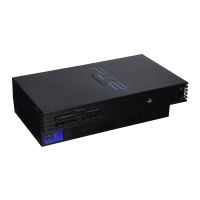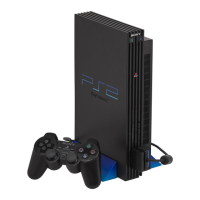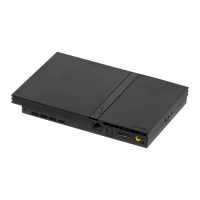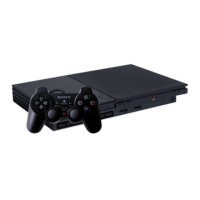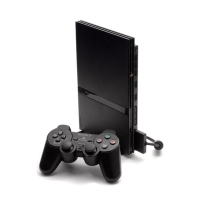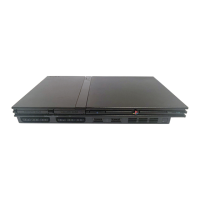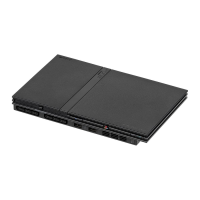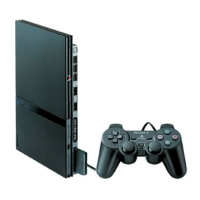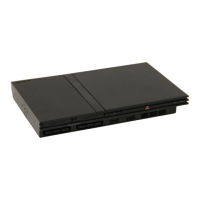Do you have a question about the Sony SCPH-70003 PS2 and is the answer not in the manual?
Advises users susceptible to seizures to consult a doctor before operation.
Specific safety instructions for UK customers regarding the mains plug and fuse.
Key safety points: prevent shock, fire, eye injury; avoid water and disassembly.
Advice on breaks, lighting, and avoiding use when tired to prevent discomfort.
Guidelines for safe and correct use of the AC adapter and power cord.
Precautions for controller use, including vibration function and stopping if discomfort occurs.
Advice on connecting to a network and compatible cable types.
Instructions for handling discs to prevent scratches and ensure proper playback.
Guidance on cleaning the console exterior and avoiding moisture condensation.
Ensures all necessary items are included; contact customer service if missing.
Instructions for placing the console horizontally or vertically using a stand.
Identifies buttons, indicators, and connectors on the front of the console.
Advice on avoiding locations with smoke, dust, extreme temperatures, or magnetic fields.
Ensures console and TV are powered off before making connections.
Step-by-step guide to connect the console to a TV using the integrated audio/video cable.
Warning about potential screen ghosting on plasma or projection TVs with static images.
Instructions for connecting the console to a TV using the Euro-AV connector plug.
Guidance on choosing cables for optimal picture quality.
Information on progressive scan, HDTV inputs, and RGB settings.
Instructions for connecting to audio devices via optical digital cable.
Setting 'Digital Out (Optical)' to 'On' in the System Configuration menu.
Instructions for inserting the Analog Controller (DUALSHOCK®2) into a controller port.
Note that some software titles require specific controller ports.
Step 1: Connect the AC power cord to the AC adapter.
Step 2: Plug the AC adapter into the console's DC IN 8.5V connector.
Step 3: Plug the AC power cord into the electrical outlet.
Check standby indicator and press the power button to turn the console on.
Press and hold the power button to put the console into standby mode.
Check connections, precautions, and network setup for online games.
Turn on console, open cover, place disc label-side up, and close cover.
Instructions for closing the disc cover to start, and pressing the button to end the game.
Steps to remove the current disc, insert a new one, and reset the console.
Diagram identifying buttons, sticks, and indicators on the controller.
How to switch between digital and analog modes and use controller functions.
Details on compatible Memory Cards (8MB and 15 block) and their capacities.
General procedure for saving and loading game data, depending on the software.
Instructions for inserting a Memory Card into the console's MEMORY CARD slot.
Steps to copy or delete game data between Memory Cards via the Browser screen.
Turn on console, insert disc, select track number, and press button to play.
Functions of controller buttons for playback, pause, fast forward/reverse, and stopping.
Options to play tracks normally, in program, shuffle, or repeat modes.
How to access and set playback options from the Browser screen.
How to start playback and display the on-screen Control Panel.
Icons and functions for DVD playback: Menu, Top Menu, Return, Audio Options, etc.
Icons for Play, Pause, Stop, Previous/Next, Search, Slow, Go To Chapter.
Icons for Setup, Angle Options, Subtitle Options, and Parental Control.
Steps to start playback and stop it using the Control Panel.
How to select scenes by chapter number, title number, or by specifying time.
How to search forwards or backwards to locate specific points on a DVD.
How to display current title, chapter number, or elapsed time during playback.
Choosing between original recorded sequence or edited content for DVD-RW playback.
Creating custom playback sequences by selecting titles and chapters.
Options for random playback of titles/chapters and repeating specific sections.
Setting a specific scene to be played repeatedly.
Resetting all selected playback modes to allow normal playback.
Steps to select settings icons (Setup, Menu, Audio, Subtitles) and change options.
Adjusting screen size (aspect ratio) for different TV types (16:9, 4:3 Letter Box, PAN SCAN).
Choosing languages for DVD menus, audio tracks, and subtitles.
Reducing image roughness for a cleaner picture using DNR1 or DNR2 settings.
Enabling progressive scan for clearer, flicker-free images on compatible TVs.
Setting picture status during paused playback (Auto or Frame).
Restricting content based on viewer age or factors, requiring a password.
List of region codes for parental control settings and geographic restrictions.
Procedure to change or clear the parental control password.
Setting Dolby Digital or DTS as the output signal for the DIGITAL OUT (OPTICAL) connector.
Setting MPEG AUDIO as the output signal for the DIGITAL OUT (OPTICAL) connector.
Prioritizing audio tracks based on channel count or predetermined order.
Adjusting DVD audio output level, with caution for distortion or hearing damage.
How to access the main menu by turning on the console without a disc.
Functions available from the Browser screen: copy/delete data, start games, audio CDs, or DVDs.
How to navigate to the System Configuration menu from the main menu.
Adjusting options like language, time display, and audio/video output methods.
Adjusting screen size (aspect ratio) for different TV types (16:9, 4:3 Letter Box, PAN SCAN).
Adjusting date, time, timezone, daylight savings, and digital audio output.
Setting video output mode (Y Cb/Pb Cr/Pr or RGB) for component AV cables.
Configuring DVD remote control functions and display language for menus.
Viewing version details for console components like Browser, CD Player, and DVD Player.
Adjusting settings like 'Diagnosis' for optimal playback.
Optimizing performance for PlayStation® format software via Disc Speed and Texture Mapping.
Procedure to reset the 'Progressive' display setting if picture quality is affected.
List of items needed for online play: Access Disc, Memory Card, broadband service.
Illustrates connection between console, modem, router, and PC.
Advises against connecting incompatible telephone or network cords to the connector.
Steps to connect the Ethernet network cable to the console and network device.
Requires a Network Access Disc and login information from your Internet Service Provider.
Note on needing the MAC Address for network setup, found in Version Information.
Lists PS2 DVD-ROM, CD-ROM, Audio CD, DVD-Video, and DVD-RW formats.
Information on PAL/NTSC standards, region codes, and compatibility.
Details optional accessories like Network Adaptor, Multitap, and Vertical Stand.
Lists accessories not compatible with this PlayStation®2 console model.
Details warranty period, coverage, and replacement policy for the console.
Explains how the guarantee relates to consumer rights in various regions.
Conditions for warranty claims: proof of purchase, intact serial number, and valid region.
Lists damages and issues not covered by the guarantee, such as misuse or unauthorized repairs.
Details power requirements, dimensions, mass, signal format, and operating temperature.
Information on the AC adapter's power requirements, output, dimensions, and mass.
Basic troubleshooting steps: check power, connections, and TV input modes.
Steps to resolve issues with no picture, including checking indicators and cables.
Solutions for picture noise, bouncing effects, and 'disc could not be read' errors.
Troubleshooting steps for no sound, aspect ratio problems, and mismatched video size.
Solutions for poor sound quality, no sound from digital audio equipment, or lack of surround effect.
Resolving problems with controllers not functioning or the console not recognizing memory cards.
Advice for static electricity issues or when the red indicator flashes.
Troubleshooting DVD playback restrictions, forgetting passwords, and inaccessible functions.
Steps to ensure correct network settings, cable connections, and provider information.
Advice to wait and retry if the network is busy or experiencing temporary issues.
Advises users susceptible to seizures to consult a doctor before operation.
Specific safety instructions for UK customers regarding the mains plug and fuse.
Key safety points: prevent shock, fire, eye injury; avoid water and disassembly.
Advice on breaks, lighting, and avoiding use when tired to prevent discomfort.
Guidelines for safe and correct use of the AC adapter and power cord.
Precautions for controller use, including vibration function and stopping if discomfort occurs.
Advice on connecting to a network and compatible cable types.
Instructions for handling discs to prevent scratches and ensure proper playback.
Guidance on cleaning the console exterior and avoiding moisture condensation.
Ensures all necessary items are included; contact customer service if missing.
Instructions for placing the console horizontally or vertically using a stand.
Identifies buttons, indicators, and connectors on the front of the console.
Advice on avoiding locations with smoke, dust, extreme temperatures, or magnetic fields.
Ensures console and TV are powered off before making connections.
Step-by-step guide to connect the console to a TV using the integrated audio/video cable.
Warning about potential screen ghosting on plasma or projection TVs with static images.
Instructions for connecting the console to a TV using the Euro-AV connector plug.
Guidance on choosing cables for optimal picture quality.
Information on progressive scan, HDTV inputs, and RGB settings.
Instructions for connecting to audio devices via optical digital cable.
Setting 'Digital Out (Optical)' to 'On' in the System Configuration menu.
Instructions for inserting the Analog Controller (DUALSHOCK®2) into a controller port.
Note that some software titles require specific controller ports.
Step 1: Connect the AC power cord to the AC adapter.
Step 2: Plug the AC adapter into the console's DC IN 8.5V connector.
Step 3: Plug the AC power cord into the electrical outlet.
Check standby indicator and press the power button to turn the console on.
Press and hold the power button to put the console into standby mode.
Check connections, precautions, and network setup for online games.
Turn on console, open cover, place disc label-side up, and close cover.
Instructions for closing the disc cover to start, and pressing the button to end the game.
Steps to remove the current disc, insert a new one, and reset the console.
Diagram identifying buttons, sticks, and indicators on the controller.
How to switch between digital and analog modes and use controller functions.
Details on compatible Memory Cards (8MB and 15 block) and their capacities.
General procedure for saving and loading game data, depending on the software.
Instructions for inserting a Memory Card into the console's MEMORY CARD slot.
Steps to copy or delete game data between Memory Cards via the Browser screen.
Turn on console, insert disc, select track number, and press button to play.
Functions of controller buttons for playback, pause, fast forward/reverse, and stopping.
Options to play tracks normally, in program, shuffle, or repeat modes.
How to access and set playback options from the Browser screen.
How to start playback and display the on-screen Control Panel.
Icons and functions for DVD playback: Menu, Top Menu, Return, Audio Options, etc.
Icons for Play, Pause, Stop, Previous/Next, Search, Slow, Go To Chapter.
Icons for Setup, Angle Options, Subtitle Options, and Parental Control.
Steps to start playback and stop it using the Control Panel.
How to select scenes by chapter number, title number, or by specifying time.
How to search forwards or backwards to locate specific points on a DVD.
How to display current title, chapter number, or elapsed time during playback.
Choosing between original recorded sequence or edited content for DVD-RW playback.
Creating custom playback sequences by selecting titles and chapters.
Options for random playback of titles/chapters and repeating specific sections.
Setting a specific scene to be played repeatedly.
Resetting all selected playback modes to allow normal playback.
Steps to select settings icons (Setup, Menu, Audio, Subtitles) and change options.
Adjusting screen size (aspect ratio) for different TV types (16:9, 4:3 Letter Box, PAN SCAN).
Choosing languages for DVD menus, audio tracks, and subtitles.
Reducing image roughness for a cleaner picture using DNR1 or DNR2 settings.
Enabling progressive scan for clearer, flicker-free images on compatible TVs.
Setting picture status during paused playback (Auto or Frame).
Restricting content based on viewer age or factors, requiring a password.
List of region codes for parental control settings and geographic restrictions.
Procedure to change or clear the parental control password.
Setting Dolby Digital or DTS as the output signal for the DIGITAL OUT (OPTICAL) connector.
Setting MPEG AUDIO as the output signal for the DIGITAL OUT (OPTICAL) connector.
Prioritizing audio tracks based on channel count or predetermined order.
Adjusting DVD audio output level, with caution for distortion or hearing damage.
How to access the main menu by turning on the console without a disc.
Functions available from the Browser screen: copy/delete data, start games, audio CDs, or DVDs.
How to navigate to the System Configuration menu from the main menu.
Adjusting options like language, time display, and audio/video output methods.
Adjusting screen size (aspect ratio) for different TV types (16:9, 4:3 Letter Box, PAN SCAN).
Adjusting date, time, timezone, daylight savings, and digital audio output.
Setting video output mode (Y Cb/Pb Cr/Pr or RGB) for component AV cables.
Configuring DVD remote control functions and display language for menus.
Viewing version details for console components like Browser, CD Player, and DVD Player.
Adjusting settings like 'Diagnosis' for optimal playback.
Optimizing performance for PlayStation® format software via Disc Speed and Texture Mapping.
Procedure to reset the 'Progressive' display setting if picture quality is affected.
List of items needed for online play: Access Disc, Memory Card, broadband service.
Illustrates connection between console, modem, router, and PC.
Advises against connecting incompatible telephone or network cords to the connector.
Steps to connect the Ethernet network cable to the console and network device.
Requires a Network Access Disc and login information from your Internet Service Provider.
Note on needing the MAC Address for network setup, found in Version Information.
Lists PS2 DVD-ROM, CD-ROM, Audio CD, DVD-Video, and DVD-RW formats.
Information on PAL/NTSC standards, region codes, and compatibility.
Details optional accessories like Network Adaptor, Multitap, and Vertical Stand.
Lists accessories not compatible with this PlayStation®2 console model.
Details warranty period, coverage, and replacement policy for the console.
Explains how the guarantee relates to consumer rights in various regions.
Conditions for warranty claims: proof of purchase, intact serial number, and valid region.
Lists damages and issues not covered by the guarantee, such as misuse or unauthorized repairs.
Details power requirements, dimensions, mass, signal format, and operating temperature.
Information on the AC adapter's power requirements, output, dimensions, and mass.
Basic troubleshooting steps: check power, connections, and TV input modes.
Steps to resolve issues with no picture, including checking indicators and cables.
Solutions for picture noise, bouncing effects, and 'disc could not be read' errors.
Troubleshooting steps for no sound, aspect ratio problems, and mismatched video size.
Solutions for poor sound quality, no sound from digital audio equipment, or lack of surround effect.
Resolving problems with controllers not functioning or the console not recognizing memory cards.
Advice for static electricity issues or when the red indicator flashes.
Troubleshooting DVD playback restrictions, forgetting passwords, and inaccessible functions.
Steps to ensure correct network settings, cable connections, and provider information.
Advice to wait and retry if the network is busy or experiencing temporary issues.
| Brand | Sony |
|---|---|
| Model | SCPH-70003 PS2 |
| Category | Game Console |
| Language | English |


